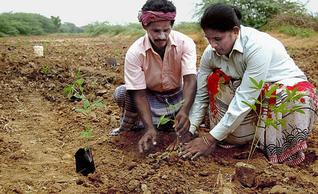The Agriculture Department has reintroduced the cultivation of red gram, one of the major pulses, in this drought prone district after a gap of more than two decades.
MIXED CROP: Farmers transplanting red gram seedlings at RS Mangalam block in Ramanathapuram./ Photo: L. Balachandar / The Hindu
Red gram was cultivated in the district as a mixed crop with paddy in rain fed areas about 25 years ago and farmers gave up the cultivation after finding it non-remunerative. Since then, the cultivation of the pulse came to a nil, with farmers settling down for paddy cultivation.
As production of Red gram was witnessing a fall in recent years, Collector K. Nanthakumar had suggested the reintroduction of the crop, after which, the department has selected progressive farmers to cultivate the pulse as a pilot project on about 20 hectares, scattered in all the blocks in the district, Joint Director of Agriculture Ka. Sakthimohan told ‘The Hindu.’
“We have taken up Red gram cultivation on an experimental basis on two hectares each in the blocks, using latest technology and practice of raising nurseries and transplanting under the National Agriculture Development Programme (NADP),” he said.
Discarding the direct sowing practice, the farmers have transplanted 35 to 40 days-old seedlings with a planting spacing of 5X3, significantly reducing the seed cost in the new method of cultivation. If 5 kg of seeds were required for direct sowing for a hectare, 2.2 kg of seeds were enough under the seedling transplantation method, he said.
The farmers have been advised to follow integrated nutrient, pest and water management for better yield, he said adding farmers are expected to get a yield of about 1.5 tonnes per hectare. Unlike the paddy crops, which required more water, three to four irrigation during the critical periods of growth-transplanting, flowering and pod-filling stages would be enough for Red gram, he said.
For achieving a good yield, the farmers have been asked to follow “earthing up” for supporting the plants and to avoid weeds. The farmers have also been asked to do nipping after 20 to 30 days after transplanting, which results in sprouting of secondary and tertiary branches, he said.
A farmer in R. S. Mangalam block, who started Red gram cultivation, assisted by the Agriculture Technology Management Agency (ATMA) said he has transplanted 500 seedlings in a hectare and expected a yield of 1 to 3 kg per plant and an overall yield of 1 to 1.5 tonnes per hectare.
Z Kamaldeen, Assistant Director of Agriculture, R.S.Mangalam block, described Red gram as an apt crop for rain-fed areas and best suited for this district. Unlike the ‘water loving’ paddy, Red gram consumed minimum water. The crop would also require only minimum fertilizer and the farmers could earn more revenue with less investment, he said.
More farmers would be encouraged to take up Red gram cultivation in this block as they could rotate the crop throughout the year and ensure sustainable income, he said. Self Help Groups would be involved in raising seedlings, he added. The foliage could be used to feed cattle, he added.
source: http://www.TheHindu.com / Home> National> TamilNadu / by Special Correspondent / Ramanathapuram, December 05th, 2012
